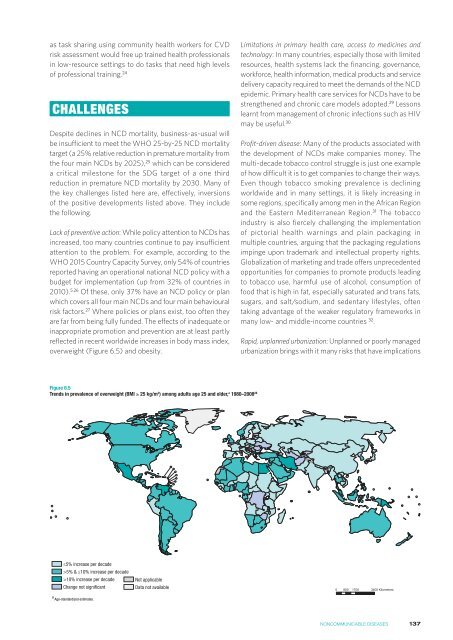Create successful ePaper yourself
Turn your PDF publications into a flip-book with our unique Google optimized e-Paper software.
as task sharing using community health workers for CVD<br />
risk assessment would free up trained health professionals<br />
in low-resource settings <strong>to</strong> do tasks that need high levels<br />
of professional training. 24<br />
CHALLENGES<br />
Despite declines in NCD mortality, business-as-usual will<br />
be insufficient <strong>to</strong> meet the WHO 25-by-25 NCD mortality<br />
target (a 25% relative reduction in premature mortality <strong>from</strong><br />
the four main NCDs by 2025), 25 which can be considered<br />
a critical miles<strong>to</strong>ne for the SDG target of a one third<br />
reduction in premature NCD mortality by 2030. Many of<br />
the key challenges listed here are, effectively, inversions<br />
of the positive developments listed above. They include<br />
the following.<br />
Lack of preventive action: While policy attention <strong>to</strong> NCDs has<br />
increased, <strong>to</strong>o many countries continue <strong>to</strong> pay insufficient<br />
attention <strong>to</strong> the problem. For example, according <strong>to</strong> the<br />
WHO 2015 Country Capacity Survey, only 54% of countries<br />
reported having an operational national NCD policy with a<br />
budget for implementation (up <strong>from</strong> 32% of countries in<br />
2010). 5,26 Of these, only 37% have an NCD policy or plan<br />
which covers all four main NCDs and four main behavioural<br />
risk fac<strong>to</strong>rs. 27 Where policies or plans exist, <strong>to</strong>o often they<br />
are far <strong>from</strong> being fully funded. The effects of inadequate or<br />
inappropriate promotion and prevention are at least partly<br />
reflected in recent worldwide increases in body mass index,<br />
overweight (Figure 6.5) and obesity.<br />
Limitations in primary health care, access <strong>to</strong> medicines and<br />
technology: In many countries, especially those with limited<br />
resources, health systems lack the financing, governance,<br />
workforce, health information, medical products and service<br />
delivery capacity required <strong>to</strong> meet the demands of the NCD<br />
epidemic. Primary health care services for NCDs have <strong>to</strong> be<br />
strengthened and chronic care models adopted. 29 Lessons<br />
learnt <strong>from</strong> management of chronic infections such as HIV<br />
may be useful. 30<br />
Profit-driven disease: Many of the products associated with<br />
the development of NCDs make companies money. The<br />
multi-decade <strong>to</strong>bacco control struggle is just one example<br />
of how difficult it is <strong>to</strong> get companies <strong>to</strong> change their ways.<br />
Even though <strong>to</strong>bacco smoking prevalence is declining<br />
worldwide and in many settings, it is likely increasing in<br />
some regions, specifically among men in the African Region<br />
and the Eastern Mediterranean Region. 31 The <strong>to</strong>bacco<br />
industry is also fiercely challenging the implementation<br />
of pic<strong>to</strong>rial health warnings and plain packaging in<br />
multiple countries, arguing that the packaging regulations<br />
impinge upon trademark and intellectual property rights.<br />
Globalization of marketing and trade offers unprecedented<br />
opportunities for companies <strong>to</strong> promote products leading<br />
<strong>to</strong> <strong>to</strong>bacco use, harmful use of alcohol, consumption of<br />
food that is high in fat, especially saturated and trans fats,<br />
sugars, and salt/sodium, and sedentary lifestyles, often<br />
taking advantage of the weaker regula<strong>to</strong>ry frameworks in<br />
many low- and middle-income countries 32 .<br />
Rapid, unplanned urbanization: Unplanned or poorly managed<br />
urbanization brings with it many risks that have implications<br />
Figure 6.5<br />
Trends in prevalence of overweight (BMI ≥ 25 kg/m 2 ) among adults age 25 and older, a 1980–2008 28<br />
≤5% increase per decade<br />
≤5% increase per decade<br />
>5% & ≤10% increase per decade<br />
>5% & ≤10% increase per decade<br />
>10% increase per decade<br />
>10% increase per decade<br />
Change not significant<br />
Change not significant<br />
Not applicable<br />
Data not available<br />
Not applicable<br />
Data not available<br />
0 1700 3400<br />
850 Kilometres<br />
0 850 1700 3400 Kilometres<br />
a Age-standardized estimates.<br />
a Age-standardized estimates.<br />
NONCOMMUNICABLE DISEASES 137


